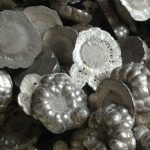Notice: Undefined index: sith_hide_share in /www/sites/alloy.wiki/index/wp-content/themes/likegoogle/single.php on line 32
Deprecated: get_settings is deprecated since version 2.1.0! Use get_option() instead. in /www/sites/alloy.wiki/index/wp-includes/functions.php on line 4862
The pickling conditions of titanium and titanium alloy bars are determined by the variety (characteristics) of the oxide layer and the existing reaction layer, which in turn is affected by the high temperature heating process and the increase of the processing temperature (e.g., forging, casting, welding, etc.). At lower processing temperatures, perhaps around 600 degrees: the higher heating temperatures below produce only thin oxide layers, and at higher temperatures an oxygen-rich dispersion is formed near some oxide layer, which is also necessary to be removed by pickling. A variety of different methods for skin removal can be selected: mechanical methods for removing the thick oxide layer and the hard outer surface layer, methods for removing the skin in molten salt bath and methods for removing the skin by pickling in acid solution.

In many cases, a combination of methods can be used, for example, mechanical dermabrasion followed by pickling, or perhaps salt bath followed by pickling. Special methods are used for oxidizing and dispersing layers at higher temperatures. However, when heated to 600 degrees Celsius, most of the oxidizing layers are dissolved by the usual pickling.
Mechanical method to remove the oxide coating usually crucible first sand blasting, polishing and brush before pickling method to remove the oxide layer formed under high temperature conditions. In any case, it is necessary to adopt measures to prevent mechanically disposed foreign substances from passing through the metal surface, which may form cracks due to reduced plasticity in subsequent thermal processing or thermal disposal processes. Corundum, emery or steel injection is usually used in the treatment of forgings. Shot peening is also used locally in the treatment of plates. To achieve the appearance quality of the titanium, it is then cold-rolled or finely ground. The thick adhesive oxide layer formed at temperature of over 750 degrees can be removed unevenly by salt bath or pickling, and this oxide layer can be removed only after grinding. In this case, it is difficult to select a lower grinding speed (5*10m/s). This prevents overheating of the grinding surface, where hardening occurs due to oxygen absorption.
It is necessary to corrode or polish the surface of the deoxidized skin to improve the surface quality several times. Defatting of the surface prior to such disposal, possible dewaxing in organic solvents to prevent stress crack corrosion as much as possible, not rich in chlorides or hydrogen carbide with similar effects, and perhaps defatting in aqueous alkaline solutions. Titanium is stable to this medium, dissolving whatever dirt the surface adheres to, but the surface itself does not corrode. In order to corrode the thinner oxide layer, acid solution can be used for corrosion. Adjust the composition of the acid solution in the pickling tank according to the external properties or characteristics of the demand. In most cases, it is rich in hydrofluoric acid as the essential substance, and in individual cases, hydrochloric or sulfuric acid is also used.
In the center of the heat treatment and heat treatment after most of the disposal requirements in terms of appearance, in order to remove the metal oxide skin appearance and various kinds of pollutants, cut the activity of the bare metal Bo appearance, as well as the table halide in titanium and its alloy coating protective layer and various functions before coating and coating process and disposal for appearance, coating the coating s is to improve the function of the metal surface, for example, to prevent corrosion, oxidation and wear, etc.
Guest contributors are welcome at the Alloy Wiki.It is a weekly wiki and guide on alloy information and processing technology, while also about the vast array of opportunities that are present in manufacturing. Our team of writers consists of a Machining Material Supplier / Machinist / Tool and Die Maker, a Biomedical Engineer / Product Development Engineer, a Job Development Coordinator / Adjunct Professor, and a President and CEO of a manufacturing facility.
Link to this article:Descaling and pickling of titanium and titanium alloy bars
Reprint Statement: If there are no special instructions, all articles on this site are original. Please indicate the source for reprinting:Alloy Wiki,thanks!^^


